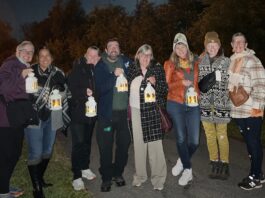The sun glistens off the edges of the icy floating block, as droplets of water stream down the gigantic exterior of the Helheim glacier flowing into the Greenland Sea.
This is the unfortunate reality of the northern Greenland glaciers that have been shrinking in size with every coming year. According to New York University researchers, Helheim is the fastest flowing glacier in the world.
Matthew Linehan is a 17-year-old student at Nepean High School, who took part in the Students on Ice (SOI) trip in August 2017.
It wasn’t until November 2016 at the Youth Climate Action Conference that he heard about SOI.
Founded by Geoff Green, social entrepreneur and expedition leader, SOI is an organization specializing in educating students about Arctic communities and climate change in ways that cannot be found in a textbook.
Linehan has always had a passion for the environment, but never thought it would one day bring him to Greenland.
Students from around the world apply to come to Canada and travel on a ship to Nunavut, through the Davis Strait, and into Greenland with their educational volunteers.
With each stop along the expedition, the students on board learn different lessons that the land has to offer.
From painting workshops, and environment seminars, to Arctic community visits, there are no lack of lessons to be learned.
“There’s only a couple of healthy glaciers in the world, the rest are receding annually,” Linehan said.
About half a million youth around the world are taking action against climate change, according to a 2015 United Nations study.
Climate change initiatives
With continuous emissions of greenhouse gases, sea levels are rising because of melting ice, a team of researchers from the University of Colorado-Boulder found. The researchers have been using satellites to track rising sea levels since 1993.
“This acceleration, driven mainly by accelerated melting in Greenland and Antarctica, has the potential to double the total sea level rise by 2100,” Steve Nerem, researcher and fellow of the Cooperative Institute for Research in Environmental Science, said.
SOI focuses on climate change in the Arctic, but the program also immerses students in Inuit culture and Greenland’s Indigenous communities.
Ashley Cummings was only 16-years-old when she went on her journey to Greenland with SOI, and is now a northern consultant advocating for mental health for North In Focus, a youth run organization dedicated to mental health counselling in northern regions of Canada, where communities have been most devastated by climate change.
“It was amazing, being supported in my history as an Inuit woman, and being honoured,” she said. “[SOI] really showed me how accessible travel is, and being able to go beyond my small community.”
SOI has completed more than 30 expeditions over the last 18 years. About 3,600 students have attended Arctic excursions, connecting them to the polar environment and Inuit communities.
This experience, although rewarding, is not affordable for everyone.
Linehan, along with many students, were not eligible for a scholarship to fund their experience.
Linehan had to raise $12,000 on his own in order to participate in the program.
Environmentalism and policy-making
Although his expedition is over, Linehan continues to stay involved in the future of climate change policy making.
He recently attended the United Nations Youth Assembly in New York in February.
Canadian youth from across the nation can apply to attend the United Nations Climate Change Conference, also referred to as COP 21, COP 22, where important climate change policies and plans are discussed by politicians, policy makers and delegates.
The most recent climate conference, COP 23, was held in Bonn, Germany in 2017, and was attended by Canada’s environment minister Catherine McKenna.
Tina Yeonju Oh, a Canadian youth delegate and divestment organizer of the Canadian Youth Delegation (CYD), was named one of Canada’s top environmentalists under 25 by Starfish Canada, in 2017.
Tina was a delegate for the Canadian Youth Climate Coalition, and participated as a formal party delegate of the Government of Canada in last year’s FCCC-Conference.
She currently works for the CYD, specializing in policy making, and said one of their biggest priorities is supporting diversity in these conferences.
“The selection process changes every year. One of the biggest priorities we have is to bring in Indigenous youth and people of colour,” Yeonju Oh said.
Within these environmental conferences like COP, people are differentiated by badges. According to the UN, there are three possible badges that a person can get, with different levels of access.
At the bottom are youth delegates, who are granted a green badge. This allows them into different zones with promotional organizations that fight against climate change, but they are not given access into closed door meetings and negotiations.
Yeonju Oh defined “youth” as any individual younger than 30, considering herself, at 20-years-old, to be a Canadian youth as well.
Moving up the ladder, there are the yellow badges. These badges are often given to civil society members, who are allowed to promote for their own organizations, and obtain access to certain negotiation meetings.
At the top of the pyramid are the pink badges. According to the UN, these badges are solely reserved for politicians, with access to negotiations and closed door meetings, and are allowed to float freely through all of the zones at the conference.
Often, youth delegates are granted yellow badges, according to the CYD, but there are no guarantees.
According to Yeonju Oh, it’s important to include youth voices throughout the negotiation process, to give them a say in what their futures will look like.
The power of youth
Now, you’re probably thinking, how much say do youth actually have?
“I think [policy makers] really do value those voices,” Yeonju Oh said.
With the encouragement of the current Liberal government, more and more youth are being given yellow badges to allow for more access to negotiations with politicians and leaders, according to the CYD.
At these international conferences, leaders from around the world discuss policies in order to reach climate change goals, such as the Paris Agreement.
The Paris Agreement
This agreement involves the reduction of greenhouse gases, which was created in Paris at the COP 21 in 2015.
The success of this agreement, according to the UN, comes down to 175 signatory parties that have accepted or signed the agreement out of the 195 parties from the entire convention.
The goal is to reduce emissions in different countries to sustain a global temperature increase of no more than 1.5˚ C this century.
However, the skepticism couldn’t be more prevalent than now.
In a tweet, President Donald Trump described climate change, as a business tactic “created by and for the Chinese,” to impede on the manufacturing competition in the United States.
He has pulled out the US’ support for the non-binding agreement, but it won’t be official until 2019, due to a three-year back out process.
According to a press release by the White House in September 2017, the United States announced they would be withdrawing from the Paris Agreement unless they could “re-engage on terms more favorable to the United States.”
The Paris Agreement has been in action since November 2016.
The first commissions reduction target report is coming up in 2020.
Canada was supposed to reduce its greenhouse gas emissions by 30 per cent of what they were in 2005.
However, Canada is not expected to meet this first target, according to the federal Commissioner of the Environment and Sustainable Development, Julie Gelfand.
Getting young voices heard
Dominique Souris, co-founder and executive director of the Youth Climate Lab, said she understands the power that young people can, and should hold on policies that affect the environment.
Souris is one of 30 top sustainability leaders under the age of 30 in Canada.
Driven in policy making and youth engagement in climate change, she created the Youth Climate Lab as a by youth, for youth organization to support innovations made collaboratively by youth themselves.
Souris, along with a group of volunteers, wants to elevate youth voices and get them involved at climate conferences.
“There is this need to build capacity for young people in the negotiations,” she said. “The more you build capacity for youth, the more they can understand and the more they can actually influence inside the negotiations.”
Ahmad Alhendawi, former UN Secretary-General’s Envoy of Youth, an organization dedicated to global youth humanitarian involvement, said youth are important in driving positive change.
“We need to invest in young people, because it’s a smart investment,” he said.
As the voices of Canadian youth grow loud across the globe, there’s no doubt that their actions are making a difference in the future of Canadian climate change initiatives.
Linehan said that youth just need to get involved if they want to join the fight against climate change.
“I established a relationship with the Arctic, that’s really never going to go away,” Linehan said. “I want to share with others, my story, so they can try and do the same.”
Graphic by Manoj Thayalan




